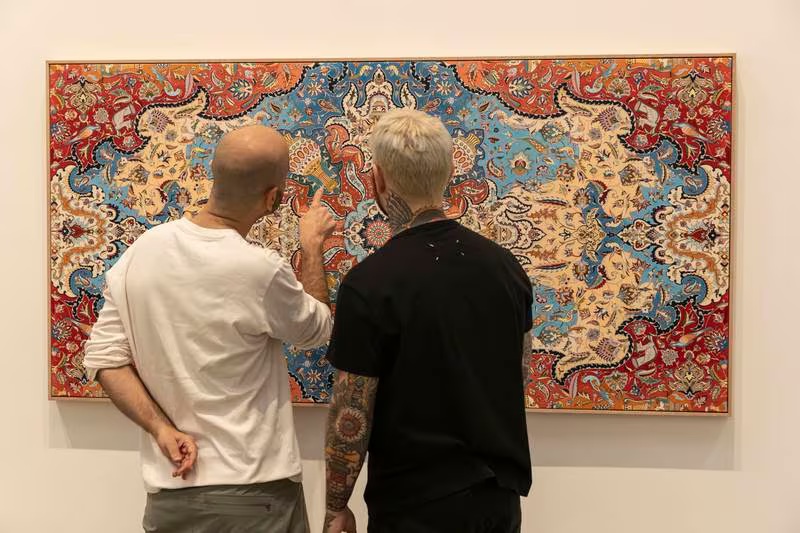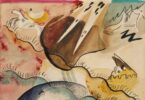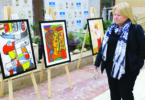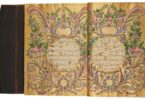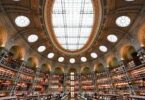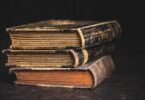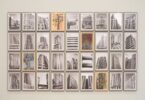Maan Jalal
Two artists are using their friendship and shared interests in the notion of infinity for a captivating exhibition in Dubai.
Entitled Duality, The Third Line gallery features pieces by Nima Nabavi and Jason Seife who worked together to create acohesive body of work despite living halfway around the world from one another.
“We knew what the goal of this exhibition was, but we didn’t know exactly what that was going to look like,” Seife tells The National.
“This is very much something that we organically came to do. We’d been talking about our work and taking inspiration from each other for a while.”
Seife, who was born to immigrant parents from Syria and Cuba in the US and lives in Miami, used the intricate patterns of traditional Persian carpets and arabesque ornamentation in unconventional materials, such as reinforced concrete, and digital works.
His stunning depictions of vegetal ornamentation and intricate details of birds and vases are displayed across four large canvases and some smaller works in the exhibition. The geometric shapes of these four canvases – a triangle, square, diamond and rectangle – are one of the obvious ways his work speaks to Nabavi’s pieces.
Nabavi, an Iranian-American, was raised in the UAE and lives in Dubai. His practice is deeply influenced by a mathematical approach where he creates complex and layered geometric drawings using pens and pencils and a sophisticated use of colour.
In theory, these works are at opposite ends of the spectrum. But in the space of the gallery, the pictorial foundation and the concepts that connect them are overpoweringly clear.
Nabavi’s work is reflected in the geometric counterparts of Seife’s work.
While each of their works can stand on their own, they come together in one, entitled Noon. The hexagon-shaped canvas, with an empty square in the centre, is made up of different panels that each painted.
:quality(70)/cloudfront-eu-central-1.images.arcpublishing.com/thenational/IUZ6KC5OYJGNVHUKVXWPGURJMQ.jpg)
“We’re both really quite meticulous and hardworking and I think maybe even rigid in the way that we work,” Nabavi says. “Despite all that, we were both really easygoing with certain things and that comes from respecting each other’s work.”
The two artists first met in 2018 when they both participated in the Sharjah Islamic Arts Festival. Both are self-taught and found themselves at similar stages in their careers as creatives trying to navigate through the art market.
They stayed in contact and developed a friendship reinforced by their practices, sharing processes and images of their ongoing work. Like studio mates, they soon developed a strong critical bond when it came to each other’s work, despite living in different parts of the world.
“This show wouldn’t have worked without trust,” says Seife. “There were moments where I had to trust that his approach to the painting was the right one and he needed to trust that mine was too.
“We were doing things that were out of our element because up until this point, we were solo workers. But now having done it, it was all very seamless.”
From Seife’s beautiful details of vines and blooming flowers sprawling across the canvas to Nabavi’s meticulous lines layered into each other creating geometric designs, they are all-encompassing worlds within themselves while seamlessly complementing each other.
While their works are influenced by the visual language of Islamic art, the artists are keen to stress that is where the similarities end.
Both Sefie and Nabavi’s works explore a type of representation of the infinite. It’s the level of extreme and excessive detail that may at first feel chaotic but quickly conveys a sense of order.
:quality(70)/cloudfront-eu-central-1.images.arcpublishing.com/thenational/FRAECRHACZBAVKI4Q3A2ASBFMY.jpg)
“There’s a feeling of familiarity in both of our work, that these things are of this life, of this universe, that they are a representation of the infinite, of the universe,” Nabavi says.
“For some people that takes a religious direction, for others maybe it’s more spiritual or aesthetic and some people don’t think about what it is. But I believe that both of us are scratching at the surface of that representation.”
Seife agrees, adding that they are both using their own alphabet to have the same conversation, which many viewers can chime into by picking at the imagery and shapes that reference their own realities.
While both artists would like audiences to also spend time with the works and see the connections and relationships between the pieces, Seife adds that their exhibition is also about inspiration.
“Being an artist, and an artist who’s a fan of other artists, when I go see an exhibition I want to be inspired,” he says. “So ideally I would want people who come and see our show to feel inspired when they leave.”
Courtesy: thenationalnews

